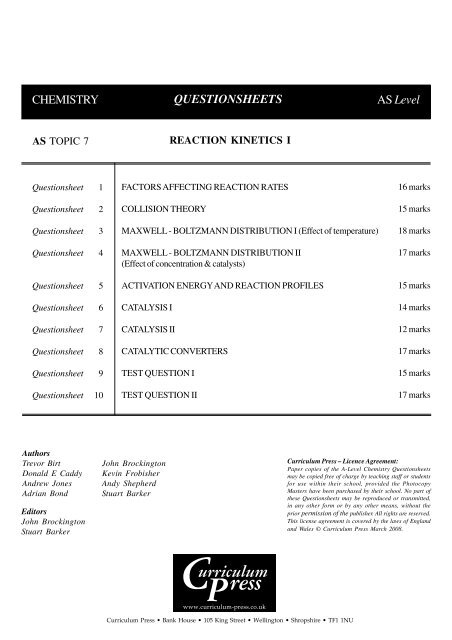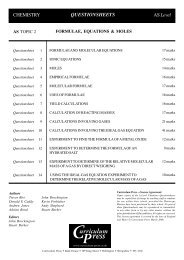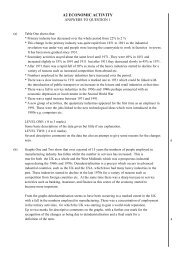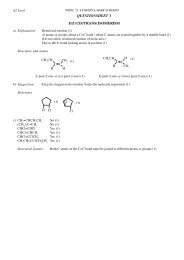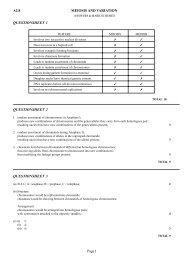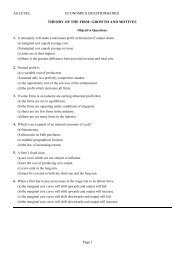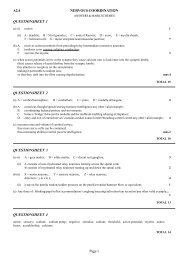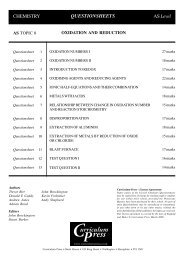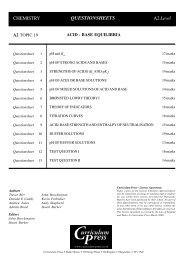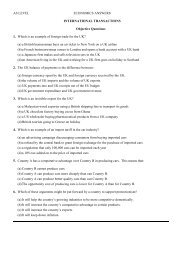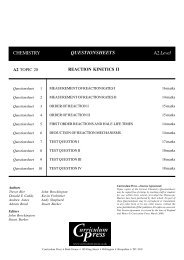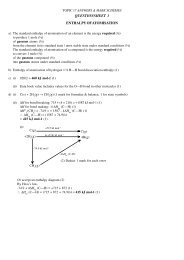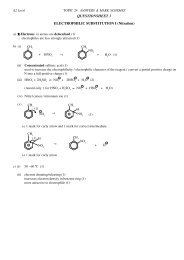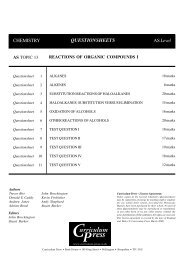reaction kinetics i - Making your chemistry studies much easier
reaction kinetics i - Making your chemistry studies much easier
reaction kinetics i - Making your chemistry studies much easier
- No tags were found...
Create successful ePaper yourself
Turn your PDF publications into a flip-book with our unique Google optimized e-Paper software.
AS LevelTOPIC 7 Questionsheet 3 ContinuedMAXWELL - BOLTZMANN DISTRIBUTION IEffect of temperatureDo notwrite inmarginb) (i) Draw and label on the same diagram, reprinted below, a curve to show the distribution of molecularenergies at a temperature T + 10 degrees.00E a[2](ii)How do you account for the fact that the new curve has a different shape from the original?................................................................................................................................................................................................................................................................................................................................................................................................................................................................................................................................................................................................................................................................................................................................................................................................................................................................................... [4](iii) Use the two curves to explain why the rate of a chemical <strong>reaction</strong> is approximately doubled for a 10degree rise of temperature................................................................................................................................................................................................................................................................................................................................................... [2]TOTAL / 18
AS LevelTOPIC 7 Questionsheet 4MAXWELL - BOLTZMANN DISTRIBUTION IIEffect of concentration and catalystsDo notwrite inmargina) The following curve shows the distribution of kinetic energies of reactant molecules at a relatively lowconcentration c 1.Number ofmolecules(i)(ii)Kinetic energyDraw on the diagram another curve to show the distribution of molecular energies (at the same temperature)at a higher concentration c 2. [1]On progressing from the curve at c 1to that at c 2, explain what differences (if any) are encountered in themean kinetic energy of molecules and the area under the curves.Mean kinetic energy ................................................................................................................................................................................................................................................................................................. [2]Area under the curves .............................................................................................................................................................................................................................................................................................. [2](iii) Use the two curves to explain why it is that <strong>reaction</strong> rate increases as concentration is increased.............................................................................................................................................................................................................................................................................................................................................................................................................................................................................................................................. [3]b) (i) Define the term catalyst................................................................................................................................................................................................................................................................................................................................................... [2](ii)Use the original distribution curve (i.e. at concentration c 1) to explain how a catalyst works...................................................................................................................................................................................................................................................................................................................................................................................................................................................................................................... [4](iii) Use <strong>your</strong> answers to a) (iii) and b)(ii) to explain why the effect on <strong>reaction</strong> rate of introducing a catalystis generally <strong>much</strong> greater than the effect of increasing concentration.............................................................................................................................................................................................................................................................................................................................................................................................................................................................................................................................. [3]TOTAL / 17
AS LevelTOPIC 7 Questionsheet 5ACTIVATION ENERGY AND REACTION PROFILESDo notwrite inmargina) Define the term activation energy.............................................................................................................................................................................................................................................................................................................................................................................................................................................................................................................................. [4]b) Figure I shows a <strong>reaction</strong> profile for an uncatalysed exothermic <strong>reaction</strong>.Figure IREACTANTSPRODUCTS(i) Label each axis. [2](ii) Mark on Figure I the enthalpy change (∆H) and the activation energy (E a). [2](iii) What kind of species does the maximum point represent?....................................................................................................................................................................... [1](iv) Sketch on Figure I the profile you would expect to see if the <strong>reaction</strong> were catalysed. [3]c) Sketch on Figure II a <strong>reaction</strong> profile for an uncatalysed endothermic <strong>reaction</strong>, and again mark on it theenthalpy change and the activation energy.Figure II[3]TOTAL / 15
AS LevelTOPIC 7 Questionsheet 6CATALYSIS IDo notwrite inmargina) A mixture of peroxodisulfate ions and iodide ions can react together in aqueous solution as follows:(i)S 2O 82-(aq) + 2I - (aq) → 2SO 42-(aq) + I 2(aq)Use the sulfur to explain why the peroxodisulfate acts as an oxidant (oxidising agent).................................................................................................................................................................................................................................................................................................................................................. [2](ii)The <strong>reaction</strong> may be catalysed by an aqueous solution of an iron(II) or iron(III) salt. Select one of thesecatalysts and write ionic equations to show the <strong>reaction</strong> mechanism................................................................................................................................................................................................................................................................................................................................................... [2](iii)Explain, in terms of ionic charges, why the <strong>reaction</strong> occurs more readily in the presence of the catalystyou have chosen than it does without a catalyst................................................................................................................................................................................................................................................................................................................................................... [2](iv) Compounds of transition elements are often encountered as catalysts. What is the essential feature of atransition element that makes such use possible?.................................................................................................................................................................................................................................................................................................................................................. [2](v)In this <strong>reaction</strong> the iron is acting as a homogeneous catalyst. In The Haber Process iron acts as aheterogeneous catalyst. Explain the meaning of each term:homogeneous ....................................................................................................................................... [1]heterogeneous ...................................................................................................................................... [1]b) State two reasons why a catalyst may be needed in an industrial process such as The Haber Process....................................................................................................................................................................... [1]....................................................................................................................................................................... [1]c) From these possibilities: acid, alkali, enzymes, nickel, platinum, iron(III) oxide,select the catalyst used in these <strong>reaction</strong>s:Esterification ................................................................................................................................................ [1]Fermentation ................................................................................................................................................ [1]TOTAL /14
AS LevelTOPIC 7 Questionsheet 7CATALYSIS IIDo notwrite inmarginManganate(VII) (MnO 4-) ions reacts with ethanedioate (C 2O 42-) ions in acid as follows:2MnO 4-(aq) + 5C 2O 42-(aq) + 16H + (aq) 2Mn 2+ (aq) + 10CO 2(g) + 8H 2O(l)a) Give ionic half-equations for this <strong>reaction</strong>.................................................................................................................................................................................................................................................................................................................................................. [2]b) This <strong>reaction</strong> can be used in volumetric analysis but a high temperature is needed. What does this suggestabout the <strong>reaction</strong>?....................................................................................................................................................................... [1]c) The amount of product is measured at different <strong>reaction</strong> times:Amount of productBATime(i) What happens to <strong>reaction</strong> rate between points A and B?....................................................................................................................................................................... [1](ii)This is said to be an example of ‘autocatalysis’. Explain what this means, suggest the catalyst in questionand give a reason for <strong>your</strong> answer to (i).Meaning .................................................................................................................................................................................................................................................................................................................. [1]Catalyst ................................................................................................................................................. [1]Reason .................................................................................................................................................. [1]d) Another manganese compound, manganese(IV) oxide, catalyses the decomposition of hydrogen peroxide:2H 2O 2(aq) → 2H 2O(l) + O 2(g)(i) Explain in energy terms how such a compound increases <strong>reaction</strong> rate............................................................................................................................................................................................................................................................................................................................................................................................................................................................................................................................. [3](ii)In what form would the catalyst be most effective and why?Form ...................................................................................................................................................... [1]Reason .................................................................................................................................................. [1]TOTAL /12
AS LevelTOPIC 7 Questionsheet 8CATALYTIC CONVERTERSDo notwrite inmargina) The exhaust gases from an internal combustion engine contain carbon monoxide, nitrogen monoxide andunburnt hydrocarbons.(i) How do you account for the presence of carbon monoxide and nitrogen monoxide?Carbon monoxide .................................................................................................................................. [1]Nitrogen monoxide ............................................................................................................................... [1](ii)State two detrimental consequences to the environment if such pollutants were discharged into theatmosphere................................................................................................................................................................................................................................................................................................................................................... [2]b) A catalytic converter changes these pollutants into relatively harmless substances.(i) Name one substance commonly used as the catalyst in these converters........................................................................................................................................................................ [1](ii)What type of catalysis occurs in a catalytic converter?....................................................................................................................................................................... [1](iii) Why is the catalyst thinly deposited on a honeycomb ceramic base?....................................................................................................................................................................... [1]c) Two typical <strong>reaction</strong>s occurring in a catalytic converter are as follows:I.......... NO(g) + ............... C 8H 18(g) → ............ CO 2(g) + ........... H 2O(g) + ............ N 2(g)II ......... CO(g) + ............ NO(g) → CO 2(g) + N 2(g)(i) Complete these equations. [2](ii)Determine the oxidation number of carbon and nitrogen in each of the carbon and nitrogen containing substances.ON of C in CO .............................................. [½]ON of C in CO 2................................................ [½]ON of N in NO ............................................... [½] ON of N in N 2.................................................. [½](iii) Using the oxidation numbers you have determined, state whether each of the pollutants, NO and CO,becomes oxidised or reduced.NO – oxidised or reduced?.................................................................................................................... [1]CO – oxidised or reduced? .................................................................................................................... [1]d) What would be the effect of using leaded petrol on a catalytic converter?....................................................................................................................................................................... [1]e) The exhaust fumes of a car fitted with a catalytic converter sometimes smell of rotten eggs. Suggest an explanation.............................................................................................................................................................................................................................................................................................................................................................................................................................................................................................................................. [3]TOTAL / 17
AS LevelTOPIC 7 Questionsheet 9TEST QUESTION IDo notwrite inmarginThe equation for the acid-catalysed hydrolysis of ethyl ethanoate is given below.CH 3COOC 2H 5(l) + H 2O(l)H + (aq)a) The H + (aq) ions act as a homogeneous catalyst.(i) Explain what is meant by the term ‘homogeneous catalyst’.CH 3COOH(aq) + C 2H 5OH(aq).................................................................................................................................................................................................................................................................................................................................................. [3](ii)Explain in general terms how a homogeneous catalyst such as H + (aq) works................................................................................................................................................................................................................................................................................................................................................... [3]b) The hydrolysis of ethyl ethanoate was performed at 25 °C and the concentration of ethanoic acid, CH 3COOH,was measured every 300 seconds. The results are given in the following table.Time / s [CH 3COOH] / mol dm -30 0.000300 0.025600 0.034900 0.0401200 0.0441500 0.047(i)Plot a graph of the results on the graph paper printed below.[4]TOTAL / 16(Continued.....)
AS LevelTOPIC 7 Questionsheet 9 ContinuedTEST QUESTION IDo notwrite inmargin(ii)Calculate the initial rate of <strong>reaction</strong>......................................................................................................................................................................................................................................................................................................................................................................................................................................................................................................................................................................................................................................................................................................... [2](iii) The experiment was repeated at 40 °C and the initial rate of <strong>reaction</strong> was calculated as20 x10 -5 mol dm -3 s -1 . Use <strong>your</strong> knowledge of the Maxwell-Boltzmann distribution to explain this result.............................................................................................................................................................................................................................................................................................................................................................................................................................................................................................................................. [3]TOTAL / 15
AS Level TOPIC 7 Questionsheet 10TEST QUESTION IIa) Catalytic converters are used in cars to decrease the level of environmentally harmful gases, such as nitrogenoxides and carbon monoxide, released from car exhausts. The catalysts used in catalytic converters arenormally finely divided solids fixed on to an inert medium.(i) Name the metal alloy usually employed in catalytic converters.Do notwrite inmargin....................................................................................................................................................................... [1](ii)Why may the metal alloy be employed as a finely divided solid?.................................................................................................................................................................................................................................................................................................................................................. [2](iii) What type of catalyst is the solid used in the catalytic converter?....................................................................................................................................................................... [1](iv) Name the three basic stages in the function of these types of catalysts.Stage 1 .......................................................................................................................................................Stage 2 .......................................................................................................................................................Stage 3 ................................................................................................................................................... [3](v)Lead-based additives are sometimes added to petrol to help combustion. Explain what effect theseadditives could have on the solid catalyst................................................................................................................................................................................................................................................................................................................................................... [2]b) It is possible to explain how these types of solid catalysts increase the rate of <strong>reaction</strong> by looking at theireffect on the Maxwell-Boltzmann distribution.(i) Label the axes below and draw on them a typical Maxwell-Boltzmann distribution curve.(ii) Clearly identify on <strong>your</strong> graph which molecules are able to take part in a <strong>reaction</strong>. [2](iii) Use the Maxwell-Boltzmann distribution curve you have drawn to explain how a catalyst increases therate of <strong>reaction</strong>.............................................................................................................................................................................................................................................................................................................................................................................................................................................................................................................................. [3]TOTAL / 17[3]


